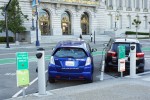The whistle of a train pierces the quiet afternoon as the carriage rocks from side to side, grimy windows framing a slow-moving California coastline.
This may sound like a scene from a docudrama about the California Gold Rush or westward expansion, but it’s actually a description of the antiquated and inconvenient commute many students make today on Amtrak’s Pacific Surfliner, a train that runs between San Diego and San Luis Obispo.
That’s where Zipcar, a short-term car-rental service, comes in. The University of California has had a partnership with Zipcar since 2013, giving students discounted memberships and on-campus access to these vehicles.
The program, however, requires students pick up and drop off cars at the same location, restricting where they can travel with these vehicles. That said, users do currently have the option of selecting Zipcar’s more expensive, multiday reservation, but this is less financially viable for students than its hourly rate service.
The UC should expand its partnership with Zipcar to allow students to pick up a car at one campus and return it at another. This increased drop-off flexibility would better connect students with the rest of California and would help them visit family and friends with greater ease. It would also help professors and teaching assistants more easily commute to conferences.
Timing and finances are both concerns when planning trips off campus.
“The difficulty (of) navigating public transportation and LA traffic while working around a class schedule makes it so difficult to leave (campus),” said Meredith Strange, a second-year pre-economics student. “People often feel trapped on campus.”
Zipcar offers reasonable hourly rates of about $9 for a short-term rental lasting less than 24 hours, or a daily rate for reservations lasting as long as a week. This would be a convenient and cost-effective alternative to public transportation and ride-sharing – were the drop-off policy more flexible.
Expanding Zipcar’s drop-off options would allow students to commute on their own schedules, rather than make them bend over backwards to fit with Amtrak or Metro’s timetables. Given that the nine UC campuses are spread across California, picking up a Zipcar at one campus and dropping it off at another would be convenient for most students’ commutes across the state.
Juliana Rico, a third-year film and television and Spanish, community and culture student, said she visits her family in San Diego once a month. She said these round-trips can cost up to $150 each, including the cost of transportation to and from Union Station, as well as the price of train tickets.
“Sometimes, you want to see your family, but you just can’t afford to do it,” Rico said. “As a student, you don’t have that much money, and this Zipcar option would make it more accessible to travel.”
It might seem like students should look into renting a car rather than advocating for policy changes on behalf of Zipcar and the UC, but students take Zipcar because of its affordable hourly rate. Students’ trips often only involve driving for a couple of hours, which doesn’t justify the financial burden of a day-long rental through another car rental company. Also, most rental companies do not rent to drivers younger than 25 years old, which excludes most students.
Were Rico able to pick up a Zipcar at UCLA and drive it to UCSD, for example, her commute would be much more efficient and affordable. Increased drop-off flexibility among UC campuses would also enable students to more easily traverse the state.
“I’m from Colombia and this is my first time living in California. I would love to be able to travel around the state, but I can’t afford to,” Rico said. “If we were able to take Zipcars between UC campuses, I could explore a lot of the cities in California.”
Students are not the only ones who would benefit from this expansion of the UC-Zipcar partnership. Professors traveling for conferences and teaching assistants commuting for research projects within California could also make use of drop-off flexibility. Departments can spend less on reimbursing faculty for airfare, instead covering the more cost-effective Zipcar hourly rate for inter-UC travel.
Luckily, UCLA seems open to this kind of program.
“If Zipcar decides it is feasible for (it) to expand the one-way program, UC and Zipcar can jointly consider the value of pick-up and drop-off parking locations at and/or adjacent to UC campuses,” said a UCLA spokesperson in an emailed statement.
And it’s clear one-way drop-offs would have significant value for students and faculty. This need for one-way drop-offs is demonstrated by the popularity of the two existing UCLA ridesharepages on Facebook, which have a combined total of about 19,000 members seeking carpool to and from UCLA.
While it might seem as though this drop-off flexibility would result in an imbalance in the number of Zipcars at the campuses that would be more popular to visit – like Los Angeles or San Francisco – the students commuting between campuses all need to make it back to their home campus eventually, which would equalize the number of cars at each campus.
The UC needs to capitalize on the opportunity to help students take the wheel in exploring California.
